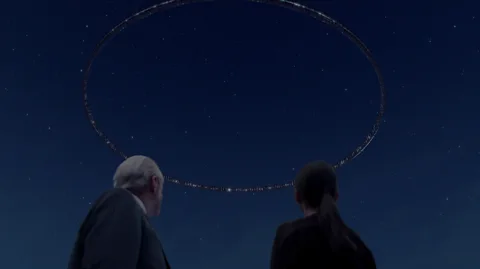
Who thought that this would be a thing for drama?
Understand that the mathematics had no exact method to tackle this problem until i came up with my higher ordered Pythagorean metrics and it will still be challenging. published june 2007 in the Journal Physics Essays by AIP. just saying.
Now imagine a simple problem. We have the Sun and Jupiter providing a dominant center of gravity. Newton got that. now imagine a small planet like earth orbiting in the eliptic plane inside the main orbit. Looks good except it has no way to avoid developing a wobble that moves that orbit back and forth outside that nice plane. and all our planets do have such a tilt.
We also know that all our planets are located in orbits of natural stability and this is caused by the primaries and we cannot calculate them using two axis math. Keplars law.
Outside those small zones of natural stability, any such object will becme increasingly unstable and be flung out of the system..
Observe we have no three star systems out there. Or higher for that matter.


What is the three-body problem? The chaotic, cosmic mathematics behind the Netflix TV show
30 March 2024
By Kit Yates,Features correspondent
https://www.bbc.com/future/article/20240328-the-science-astronomy-and-mathematics-of-netflixs-3-body-problem-tv-show?u
NetflixThe three suns of a distant alien system drive the drama in 3 Body Problem (Credit: Netflix)
In Netflix's 3 Body Problem – based on Liu Cixin's sci-fi novels – the drama is inspired by a real scientific conundrum in astronomy. Mathematician Kit Yates explains.
What links Sir Isaac Newton, alien solar systems, and a new multi-million dollar TV show on Netflix?
The answer is "the three-body problem": a conundrum in astronomy and mathematics that describes why it's often difficult to predict the long-term trajectory of planets, moons and stars.
So, what exactly is the problem? And how did it end up becoming the title of a Netflix TV series?
To understand, you first need to know a bit about the background to the TV show, and its premise. The story is based on Liu Cixin's epic sci-fi trilogy, the Remembrance of Earth's Past, of which The Three-body Problem is the first book. The original trilogy is characterised by the author's attention to scientific detail. The adaptation is less so, but still crammed with scientific ideas.
The TV series focuses on the ''Oxford Five'', who all studied under the same professor at the University of Oxford. Some have gone on to become scientists themselves (a post-doctoral physics researcher, a founder and chief scientific officer of a nano-tech company, and a theoretical physics academic), one has become a school physics teacher, while the fifth is now a snack-food entrepreneur. Scientific credentials abound.

NetflixThe characters in the TV show come to realise they can't predict how a chaotic three-body solar system will evolve (Credit: Netflix)
The crux of the story is that an alien race – called the Trisolarans or San-Ti Ren – is headed to Earth to colonise it. Through intergalactic communication, these travellers attempt to intimidate human scientists into slowing down our rapid technological advancement, making Earth easier to conquer.
But why are these aliens so hell-bent on taking over our planet in the first place? This is where the three-body problem comes in.
Bodies, in this context, is a scientific byword for planets, moons, suns or any other massive astronomical object. The extraterrestrials' home planet is situated in a solar system with three suns, hence their name in the English translation of the book – the Trisolarans. This three-sun system can be highly unstable, making conditions difficult for life, hence the desire to travel across the Universe in order to inhabit our relatively stable Solar System. We only have one Sun, so Earth's future is relatively predictable – at least for the next few million years.
We know this thanks to Sir Isaac Newton's Universal Law of Gravitation, published in 1687, which describes the gravitational forces exerted by one body on another. His simple equation allowed astronomers to model the relationship between two large bodies such as the Earth and the Sun. Earth has a regular orbiting period lasting roughly 365.24 days – one solar year. Similarly, the Moon rotates around the Earth approximately every 27.3 days – another apparently stable two-body system. In theory, Newton, armed with his two-body solution, could predict the positions of the planets, moons and comets of the Solar System way into the future.

NetflixThe bodies in 3 Body Problem are distant suns and planets in an alien solar system (Credit: Netflix)
In reality, Newton's two-body solution was only ever an approximation of the real Solar System. In general, the influence of the smaller bodies – such as moons or other planets – on larger ones cannot be completely ignored. Instead of a two-body problem, our Solar System instead comprises what is known as an n-body problem. Such problems cannot be solved, in general, using traditional mathematical techniques to give exact answers. Worse than that, the trajectories predicted by such systems allow for chaos.
Chaos, in the mathematical sense, does not refer to its common usage of "disarray and disorganisation". Instead, it is often characterised by what mathematicians refer to as sensitive dependence on initial conditions. This means that the behaviour of two otherwise identical chaotic systems, initiated with extremely similar (but not exactly identical) initial conditions, will eventually become vastly different from each other.
Although Newton's laws can give seemingly accurate predictions of our Solar System's future configuration, the motions of the celestial bodies within it are actually chaotic, because in reality there are more than two bodies. This planetary chaos emerges on long timescales – a chaos-horizon of the order of tens to hundreds of millions of years. So eventually, a planet might be found on the opposite side of the Solar System to where today's calculations would locate it. This isn't because of any randomness in the planets' dynamics – Newton's laws describe their motion well – but a result of the fact that the motion of three or more celestial bodies can be a chaotic system.
San Ti Ren: Living with three suns
In the TV series, the bodies in question are three relatively massive suns of a trisolar system – the original home of the San Ti Ren (which means ''three-body people'' in Mandarin). And the chaos is much more obvious. In their corner of the Universe, the motion of the suns is inherently chaotic and unstable, meaning they face the prospect of being swallowed up by one of them, or spat out of the system altogether.
To communicate this complex scientific idea, two of the Oxford Five scientists play a hyper-realistic virtual reality video game. The participants pitch into different historical human civilisations that are all seemingly subject to the whims of a trisolar system. As the game progresses, some of history's more famous scientists take on the challenge of preparing political and religious leaders for the chaos.
Watch Jin, one of the Oxford Five, trying to convince a Catholic pope of her three-body theory in a "middle-ages" level of the VR video game:
One level of the game sees Newton team up with computer scientist Alan Turing to solve Newton's Universal Law of Gravitation on a human realisation of one of Turing's computing machines. Sadly, their resulting predictions are off the mark, which leads to their death and the abrupt end of the entire simulated civilisation.
Appreciating that the San-Ti will never predict or control the chaotic trajectories of their planet, the Oxford Five gamers eventually realise that the aliens must abandon their home to save their people.
The three-body problem is, then, the root cause of all the drama that plays out throughout the rest of the series, and potentially the next two series the show's creators have planned.
How will the story pan out? You could try to look ahead by reading the books, but the TV showrunners may have other ideas. As with planets and suns, when there's a third party involved, there's always room for the unpredictable.
No comments:
Post a Comment